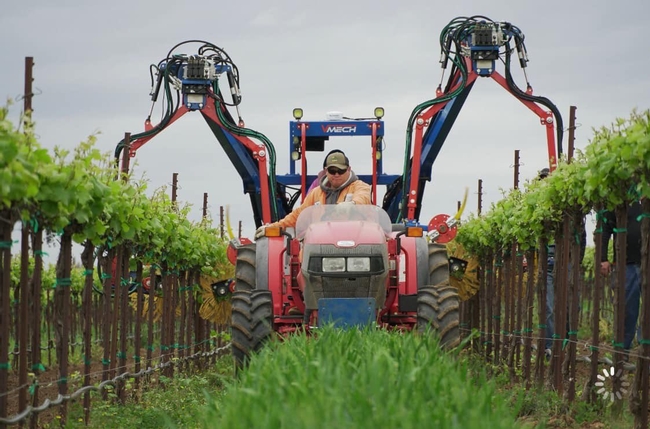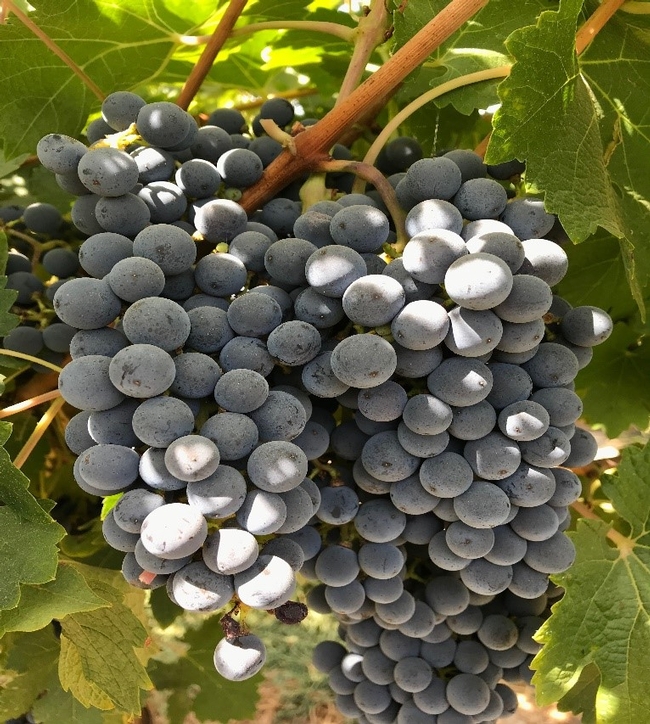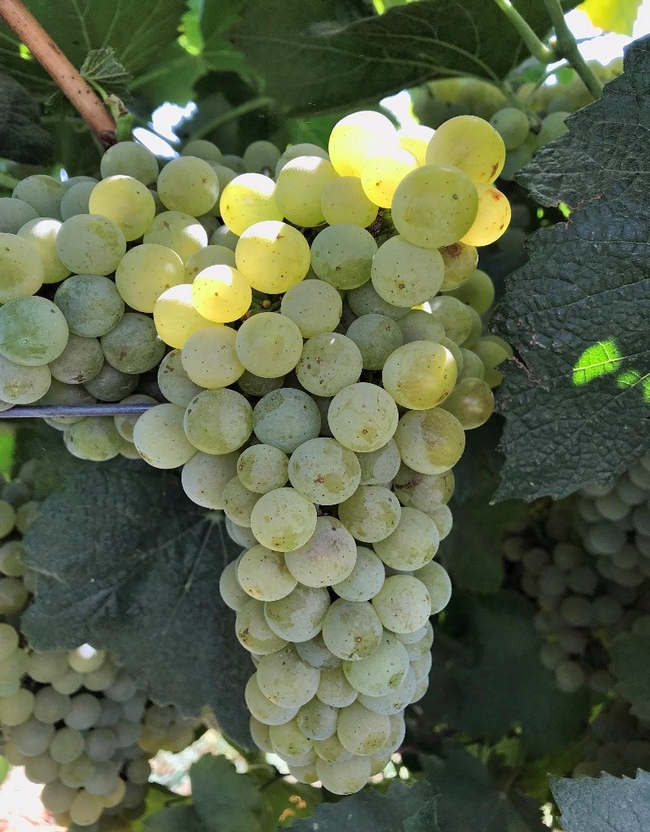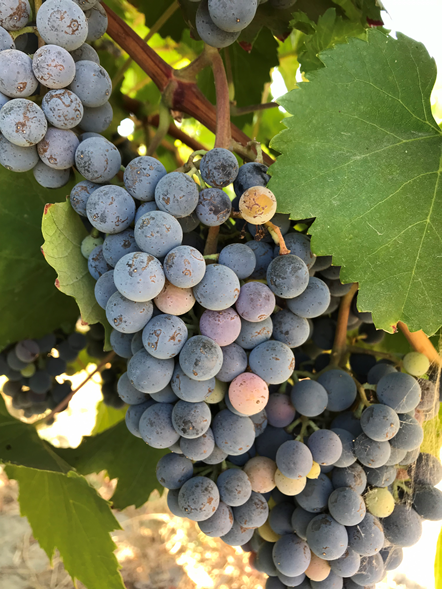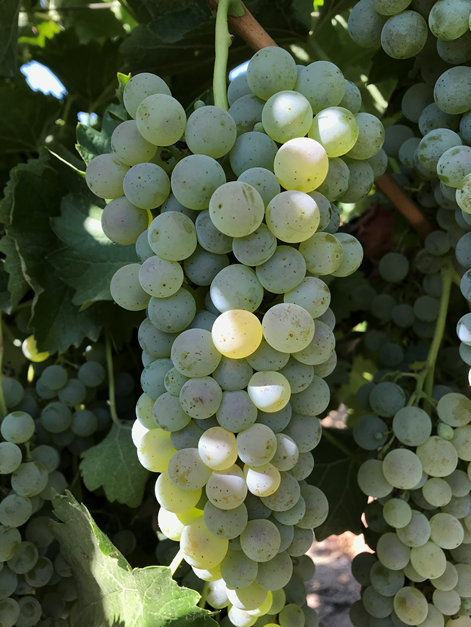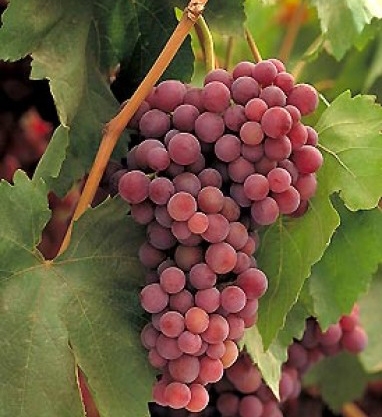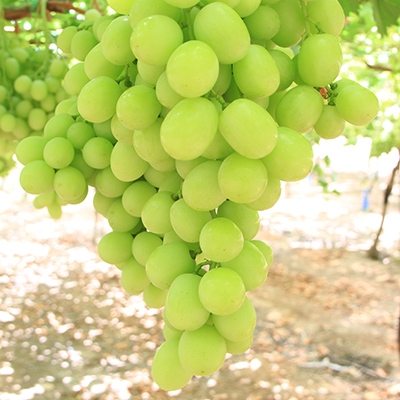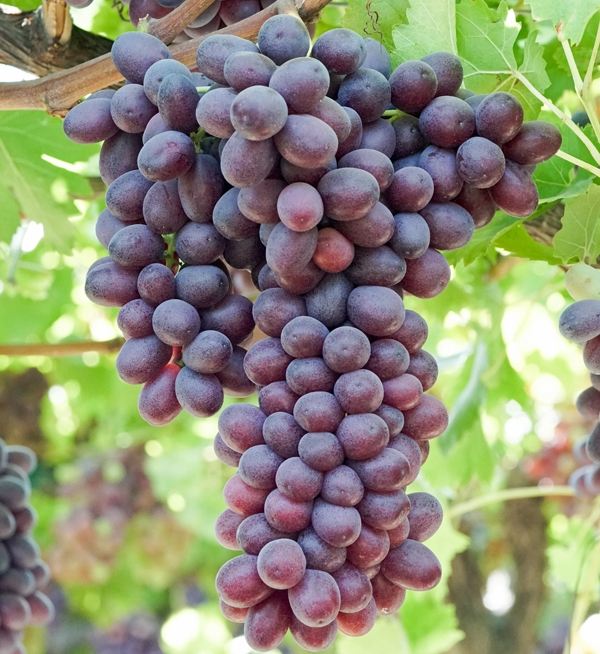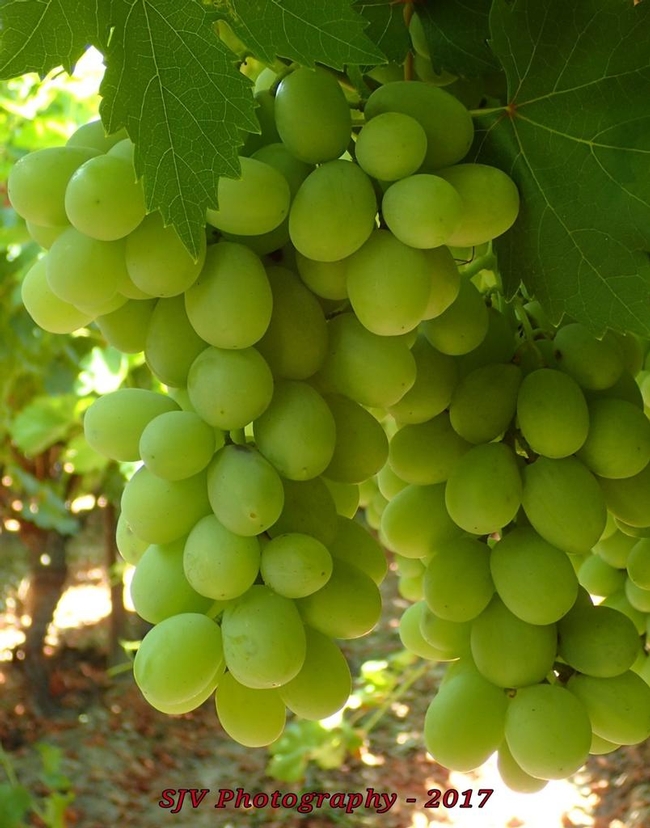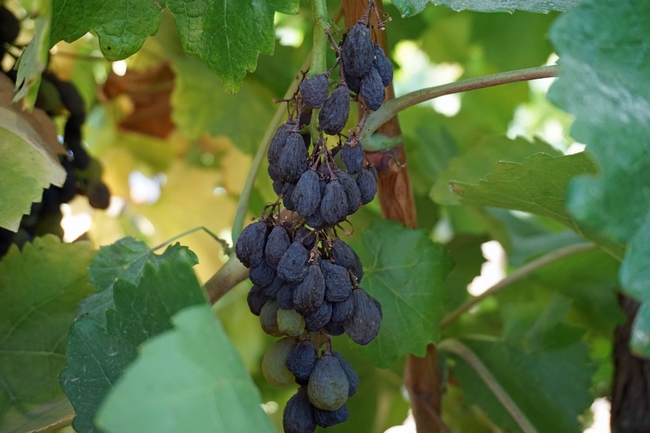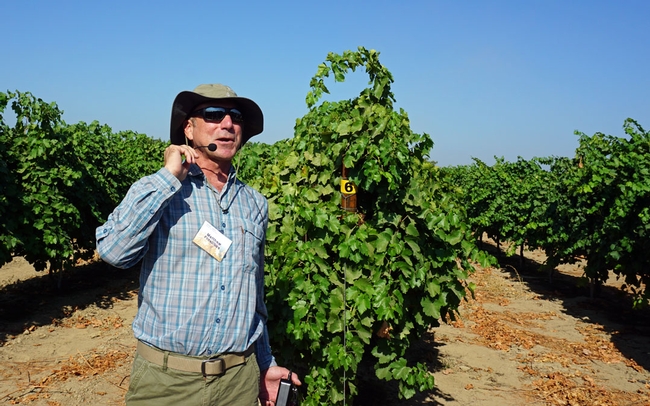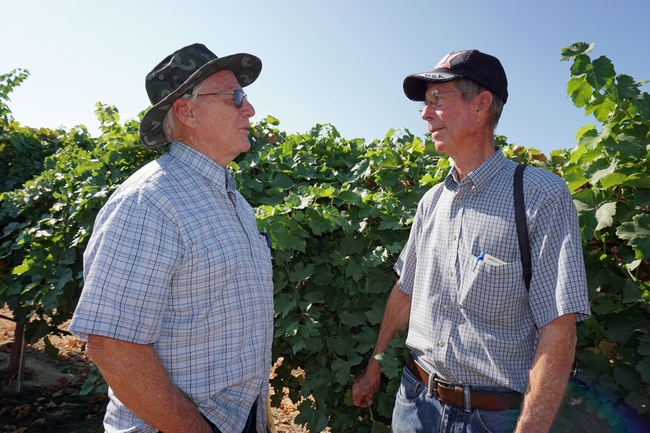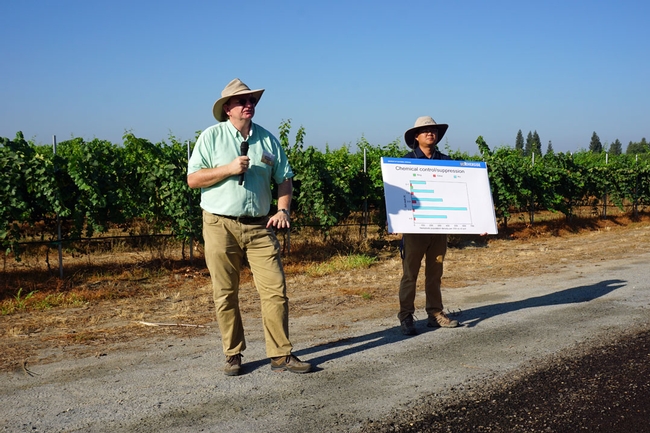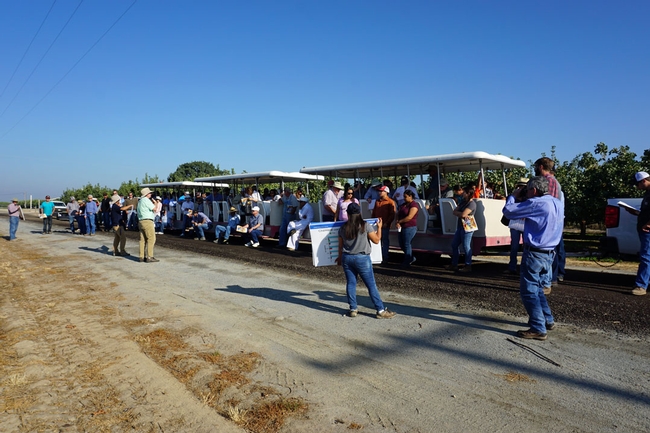Posts Tagged: George Zhuang
UC releases new cost studies for mechanized winegrape production
New studies provide details about trellis type, planting density, cost and potential benefit of vineyard mechanization
UC Agriculture and Natural Resources' Agricultural Issues Center has released four new studies detailing the costs and returns of wine grape production in the southern San Joaquin Valley. All four cost studies illustrate the cost and benefit of nearly full mechanization on wine grape production.
The studies estimate the cost of establishing a vineyard and producing wine grapes, focusing on four wine grape varieties – Cabernet Sauvignon, Chardonnay, Rubired and Colombard.
“Those studies take into consideration mechanical pruning, leafing, shoot thinning, and harvest on a typical wine grape vineyard with the average production level for this region,” said George Zhuang, UC Cooperative Extension viticulture advisor in Fresno County.
“With farming labor becoming more scarce and expensive, growers will opt to transition into more mechanization,” Zhuang said. “These studies provide detailed information about the trellis type, planting density, cost and potential benefit of vineyard mechanization. Based on these studies, fully implemented mechanization reduces the production cost from $3,000 to $2,500 per acre and that represents 17% cost reduction. This information will ultimately help growers to guide their production practices to more profitable and competitive ways under the new era of farming labor.”
Wine grape growers should look at the costs, particularly expenses associated with mechanization, Zhuang said.
“The investment to purchase and own equipment can be high,” Zhuang said. “Fortunately, it is easy to find a contractor in this region to perform certain vineyard tasks, if the initial investment to purchase equipment is prohibitive.”
Numerous studies, including UC studies, have confirmed the benefits of vineyard mechanization to grape and wine quality with lower production costs.
“It is a win-win-win situation,” Zhuang said. “Growers can improve their farming margins, wineries and juice processing plants can get reliable and higher quality grapes and juice from farms, and average consumers can enjoy better wine and more healthy grape products at an affordable price.”
The studies are based on 200-acre farms with the vineyard established on 40 acres using two types of trellis systems – quadrilateral cordon system and bilateral cordon system. In addition to regular grape production expenses – such as irrigation, fertilization and pest control – the researchers broke out the differences between machinery costs and hand labor hours required for thinning, pruning and harvesting for each variety.The prices for labor, materials, equipment and custom services are based on October 2019 figures.
The California minimum wage law will gradually decrease the number of hours employees can work on a daily and weekly basis before overtime wages are required. For more information and to view the California minimum wage and overtime phase-in schedules visit aic.ucdavis.edu.
Input and reviews were provided by UC Cooperative Extension farm advisors, specialists, grower cooperators and other agricultural associates. The authors describe the assumptions used to identify current costs for wine grape establishment and production, material inputs, cash and non-cash overhead. A ranging analysis table shows profits over a range of prices and yields.
The new studies are:
- 2019 - Sample Costs to Establish and Produce Winegrapes in the Southern San Joaquin Valley – Chardonnay Variety
- 2019 - Sample Costs to Establish and Produce Winegrapes in the Southern San Joaquin Valley –Cabernet Sauvignon Variety
- 2019 - Sample Costs to Establish and Produce Winegrapes in the Southern San Joaquin Valley – Rubired Variety
- 2019 - Sample Costs to Establish and Produce Winegrapes in the Southern San Joaquin Valley – Colombard Variety
All four winegrape studies can be downloaded from the UC Davis Department of Agricultural and Resource Economics website at http://coststudies.ucdavis.edu. Sample cost of production studies for many other commodities are also available on the website.
For additional information or an explanation of the calculations used in the studies, contact Donald Stewart at the Agricultural Issues Center at (530) 752-4651 or destewart@ucdavis.edu.
For information about local grape production, contact George Zhuang, UCCE viticulture advisor for Fresno County, at gzhuang@ucanr.edu; UCCE viticulture specialist Matt Fidelibus at mwfidelibus@ucanr.edu; UCCE viticulture specialist Kaan Kurtural at skkurtural@ucdavis.edu; Karl Lund, UCCE viticulture advisor for Madera, Merced and Mariposa counties, at ktlund@ucanr.edu; or Gabriel Torres, UCCE viticulture advisor for Kings and Tulare counties, at gabtorres@ucanr.edu.
New labor laws factored into UC cost studies for table grape production
To help table grape growers make decisions on which varieties to grow, the UC Agriculture and Natural Resources' Agricultural Issues Center has released four new studies on the costs and returns of table grapes in the Southern San Joaquin Valley. The studies on different table grape varieties are each based on a 500-acre farm with vineyard establishment on 40 acres.
The studies focus on four table grape varieties. There are two early maturing varieties, Flame Seedless and Sheegene-21, that begin harvest in July, one mid-season maturing, Scarlet Royal, and one late maturing, Autumn King, which begins harvest in October. The studies estimate the cost of establishing a table grape vineyard and producing fresh market table grapes.
“Labor costs are expected to rise with reduced labor availability, increases in minimum wage rates and new overtime rules that went into effect in 2018,” said Ashraf El-kereamy, UCCE viticulture advisor in Kern County and co-author of the cost studies.
“We included detailed costs for specialized hand labor of certain cultural and harvest operations.”
The sample costs for labor, materials, equipment and custom services are based on January 2018 figures. A blank column, titled “Your Cost,” is provided in Tables 2 and 3 for growers to enter their own estimated costs.
“The new California minimum wage law will gradually decrease the number of hours employees can work on a daily and weekly basis before overtime wages are required. There are additional stipulations for overtime wages and scheduling of work that are part of the new law,” said Daniel Sumner, director of the Agricultural Issues Center.
Input and reviews were provided by UC ANR Cooperative Extension farm advisors, specialists, grower cooperators, California Table Grape Commission and other agricultural associates. The authors describe the assumptions used to identify current costs for table grape establishment and production, material inputs, cash and non-cash overhead. A ranging analysis table shows profits over a range of prices and yields. Other tables show the monthly cash costs, the costs and returns per acre, hourly equipment costs, and the whole farm annual equipment, investment and business overhead costs.
The new studies are:
- “2018 - Sample Costs to Establish and Produce Table Grapes in the Southern San Joaquin Valley – Flame Seedless, Early Maturing”
- “2018 - Sample Costs to Establish and Produce Table Grapes in the Southern San Joaquin Valley – Sheegene-21 (Ivory™), Early Maturing”
- “2018 - Sample Costs to Establish and Produce Table Grapes in the Southern San Joaquin Valley – Scarlet Royal, Mid-season Maturing”
- “2018 - Sample Costs to Establish and Produce Table Grapes in the Southern San Joaquin Valley – Autumn King, Late Maturing”
All four table grape studies can be downloaded from the UC Davis Department of Agricultural and Resource Economics website at http://coststudies.ucdavis.edu. Sample cost of production studies for many other commodities are also available at the website.
For additional information or an explanation of the calculations used in the studies, contact Donald Stewart at the Agricultural Issues Center at (530) 752-4651 or destewart@ucdavis.edu.
For information about local table grape production, contact UC Cooperative Extension viticulture specialist Matthew Fidelibus at mwfidelibus@ucanr.edu, UCCE viticulture advisor Ashraf El-kereamy in Kern County at aelkereamy@ucanr.edu, UCCE entomology advisor David Haviland in Kern County at dhaviland@ucdavis.edu, UCCE weed advisor Kurt Hembree in Fresno County at kjhembree@ucanr.edu, or UCCE viticulture advisor George Zhuang in Fresno County at gzhuang@ucanr.edu.
Sunpreme raisins a hit at the UC Kearney Grape Day 2017
Excitement over the new Sunpreme raisins was evident at UC Kearney Grape Day Aug. 8, 2017. As soon as the tram stopped, dozens of farmers and other industry professionals rushed over to the vineyard to take a close look and sample the fruit. Raisins pulled from the vine were meaty with very little residual seed. The flavor was a deep, sweet floral with a muscat note.
Sunpreme raisins, bred by now-retired USDA breeder David Ramming, promise a nearly labor-free raisin production system. Traditionally, raisins are picked and placed on paper trays on the vineyard floor to dry. The development of dried-on-the-vine varieties opened the door to greater mechanization. Workers would cut the stems above clusters of grapes, which then dry out in the canopy and are harvested mechanically. The new wrinkle with Sunpreme is that grapes ripen and then start to dry on their own - no cane cutting needed.
UC Cooperative Extension viticulture specialist Matthew Fidelibus and UCCE viticulture advisor George Zhuang are now studying the performance of Sunpreme grapes on different rootstocks and trellis systems at the UC Kearney Agricultural Research and Extension Center.
"We didn't know a lot about this variety," Fidelibus said. "We've found it to be very vigorous."
Fidelibus said the raisins take about a month to dry, and one challenge is the tendency for dried raisins to drop off the vine.
"We want to keep the self drying and stop self dropping," he said.
Ramming discovered the Sunpreme variety in a Thompson seedless table grape variety trial in the mid-1990s. He was going down the row, saw clusters of raisins and screeched to a stop. He had discovered Sunpreme. The variety is not yet available for commercial production.
Fighting nematodes with new solutions
Also during Grape Day 2017, UC Cooperative Extension nemotology specialist Andreas Westphal outlined research underway to keep nematodes at bay.
"There's no methyl bromide in commercial planting," Westphal said. The very effective fumigant was banned because of it's tendency to deplete ozone in the atmosphere and the risk to human health because of its toxicity. Many farmers have turned to Telone as an alternative, however it is expensive and its use is limited by a township cap.
Westphal is comparing alternative treatments for clearing the soil of the tiny worms that feed on vine roots and inhibit vineyard productivity.
"Some companies are coming up with new chemistry," Westphal said. "Our challenge in the perennial world is that the roots go so deep."
Seven new products and Telon were drenched in different replicated research plots. Some areas were left alone to serve as control. Three times the number of Sauvignon Blanc vines were planted in the plots compared to a typical vineyard so researchers could take out plants twice and examine the roots for evidence of pests.
"We are excited to see significant growth differences among the treatments," Westphal said, pointing out a row that was visibly shorter and less vigorous. "It amazed me. Three years after treatment, and it never grew back out of it."
Work is still ongoing, but Westphal said he believes some chemical treatment could be available in the future to help reduce nematode pressure.
To deal with nematode populations, Westphal encouraged growers to sample soil and communicate with the diagnostic laboratory to determine what pest nematodes are in their vineyards, and then use that information for root stock selection.
"Growers should not forget the value of nematode-resistant rootstocks," he said. "Plant material needs to be chosen very carefully when different species of nematodes are present."


